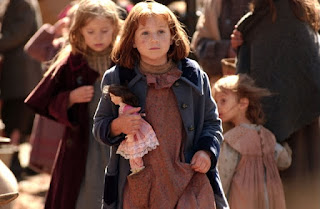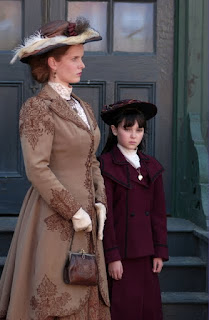Based on the incredibly popular American Girl historical fiction series of children's books by Valerie Tripp -- that also tied in with the former mail-order company's doll collection -- Samantha: An American Girl Holiday
Structurally Samantha is reminiscent of another turn-of-the-century set coming-of-age tale, Meet Me in St. Louis
Subtly announcing its emphasis on girl power throughout the film's credits by listing the names of its largely female behind-the-scenes staff, Samantha is divided into four seasons of what would become the fateful character defining year in the life of young orphan Samantha Parkington (Race to Witch Mountain's AnnaSophia Robb).
The eighty-six minute work begins with the arrival of three servant girls around Samantha's age to work next door to where our heroine resides with her kind but old-fashioned “Grandmary” (Mia Farrow) in the fictional New York community of Mount Bedford situated on the Hudson River, until Marsha Norman's screenplay comes full circle with an uplifting holiday conclusion.
Eager to break societal tradition and unafraid of taboos, Samantha befriends the servants with whom she shares a property line and convinces sweet Irish immigrant Nellie O'Malley (Kelsey Lewis) that it's never to late to learn to read by teaching the girl herself.
Startled to discover that her charismatic, impulsive and doting Uncle Gard (Beau Bridges' son, actor Jordan Bridges) is preparing to marry actress Rebecca Mader's forward thinking suffragette Cornelia over the summer, Samantha's in for an even bigger surprise when the newlyweds ask her to leave Mount Bedford and come stay with them in the Big Apple for the fall.
Although we wish that topics like child labor issues, factory injustices for workers and women's voting rights would've been handled in a more contemplative matter given its target audience of knowledge-hungry children, Samantha admirably -- albeit gently -- incorporates historical markers, educating viewers as to where we were back in 1904 in terms of technology, laws, transportation, welfare, and overcrowding.
At times Samantha is guilty of preying on our need for nostalgic nourishment by encouraging us to look the other way during some overly convenient character developments and the oversimplification of a very complicated issue that occurs in the last half of the movie, which makes the children's naivete and slightly wooden dialogue a bit more problematic.
Although it doesn't compare to the superior big screen series feature Kit Kittredge
Text ©2010, Film Intuition, LLC; All Rights Reserved. http://www.filmintuition.com Unauthorized Reproduction or Publication Elsewhere is Strictly Prohibited and in violation of the Digital Millennium Copyright Act.
FTC Disclosure: Per standard professional practice, I received a review copy of this title in order to evaluate it for my readers, which had no impact whatsoever on whether or not it received a favorable or unfavorable critique.









.jpg)










